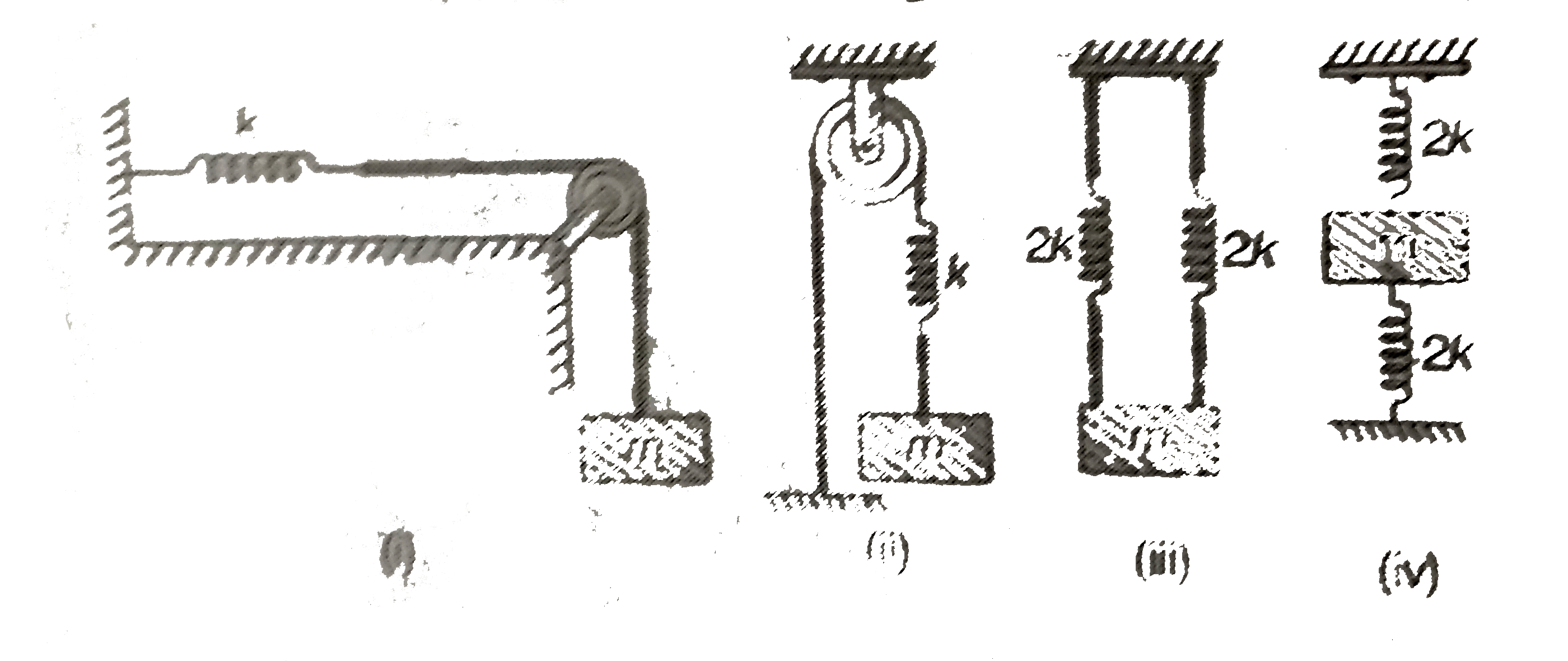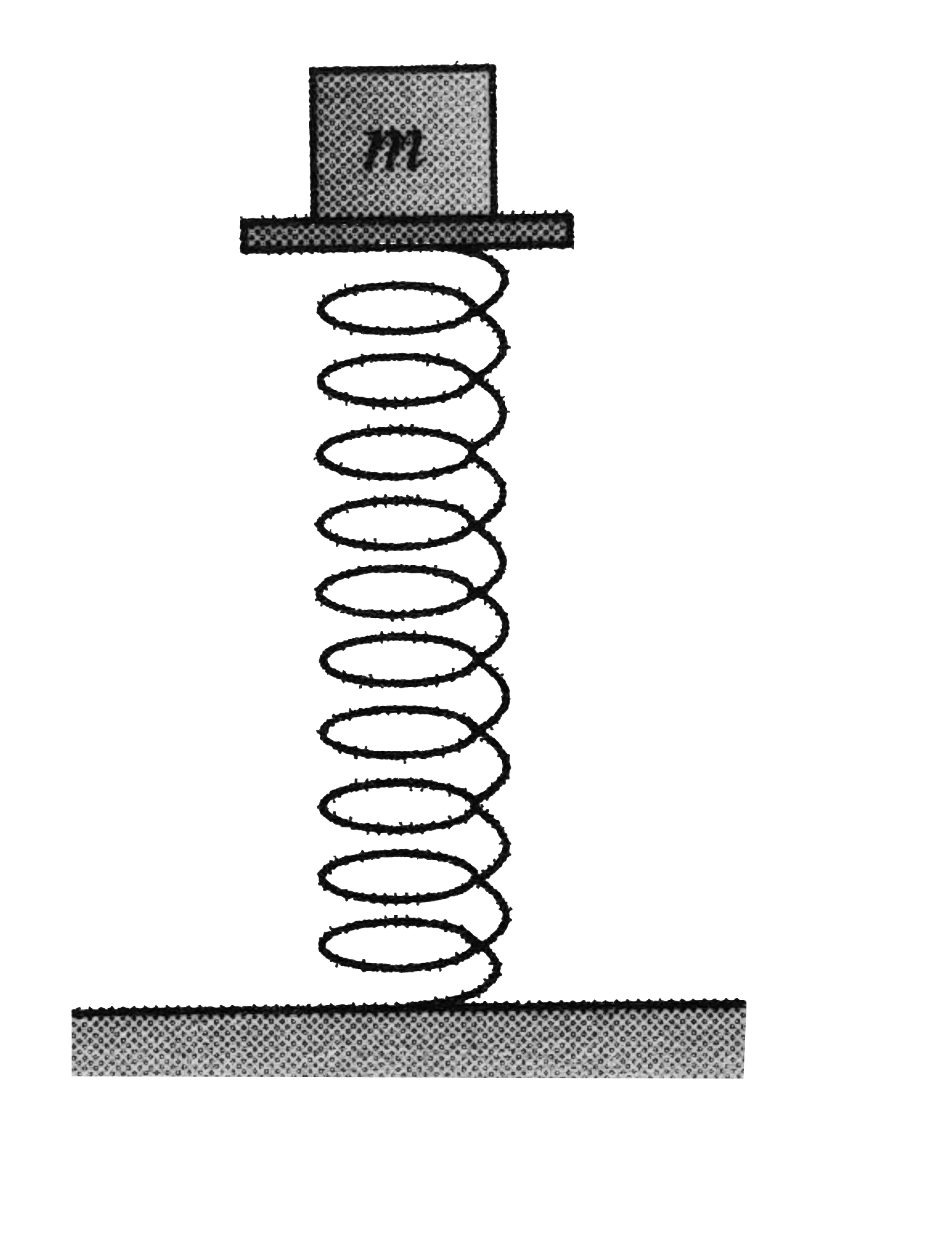A block of mass m suspended from a spring of spring constant k. Find the amplitude of S.H.M.
To find the amplitude of simple harmonic motion (S.H.M.) for a block of mass m suspended from a spring with spring constant k, we can follow these steps:
1. Understanding the System:
- We have a mass m attached to a spring with spring constant k. When the mass is at rest, the spring is neither stretched nor compressed.
2. Identify the Equilibrium Position:
- When the mass is attached and allowed to come to rest, it will stretch the spring to a new equilibrium position due to the force of gravity acting on the mass. At this point, the spring force equals the weight of the mass.
3. Setting Up the Forces:
- The weight of the block is given by \( W = mg \).
- The spring force when stretched by an amount \( x_0 \) is given by Hooke's Law: \( F = kx_0 \).
4. Equating Forces at Equilibrium:
- At equilibrium, the spring force equals the weight of the block:
\(
kx_0 = mg
\)
5. Solving for the Amplitude:
- Rearranging the equation gives:
\(
x_0 = \frac{mg}{k}
\)
- This \( x_0 \) represents the maximum displacement from the equilibrium position, which is the amplitude of the S.H.M.
6. Final Result:
- Therefore, the amplitude \( A \) of the simple harmonic motion is:
\(
A = \frac{mg}{k}
\)
- We have a mass m attached to a spring with spring constant k. When the mass is at rest, the spring is neither stretched nor compressed.
- When the mass is attached and allowed to come to rest, it will stretch the spring to a new equilibrium position due to the force of gravity acting on the mass. At this point, the spring force equals the weight of the mass.
- The weight of the block is given by \( W = mg \).
- The spring force when stretched by an amount \( x_0 \) is given by Hooke's Law: \( F = kx_0 \).
- At equilibrium, the spring force equals the weight of the block:
\(
kx_0 = mg
\)
- Rearranging the equation gives:
\(
x_0 = \frac{mg}{k}
\)
- This \( x_0 \) represents the maximum displacement from the equilibrium position, which is the amplitude of the S.H.M.
- Therefore, the amplitude \( A \) of the simple harmonic motion is:
\(
A = \frac{mg}{k}
\)
Topper's Solved these Questions
- BOOK - ALLENCHAPTER - SIMPLE HARMONIC MOTIONEXERCISE - Exercise-01117videos
SIMPLE HARMONIC MOTION
- BOOK - ALLENCHAPTER - SIMPLE HARMONIC MOTIONEXERCISE - Exercise-0219videos
SIMPLE HARMONIC MOTION
- BOOK - ALLENCHAPTER - RACEEXERCISE - Basic Maths (Wave Motion & Dopplers Effect) (Stationary waves & doppler effect, beats)25videos
RACE
- BOOK - ALLENCHAPTER - TEST PAPEREXERCISE - PHYSICS4videos
TEST PAPER
Similar Questions

The period of oscillation of a mass M suspended from a spring of spring constant K is T. the time period of oscillation of combined blocks isView SolutionA block of mass m hangs from a vertical spring of spring constant k. If it is displaced from its equilibrium position, find the time period of oscillations.
View Solution
Knowledge Check
- Question 1 - Select One
A block of mass m is suspended by different springs of force constant shown in figure.
 AT1=T2=T4BT1=T2andT3=T4CT1=T2=T3DT1=T3 and T2=T4
AT1=T2=T4BT1=T2andT3=T4CT1=T2=T3DT1=T3 and T2=T4 - Question 2 - Select One
Two masses m1and m2 are suspended from a spring of spring constant 'k'. When the masses are in equilibrium, m1 is gently removed. The angular frequency and amplitude of oscillation of m2 will be respectively
A√Km2,m1gKB√Km1,m2gKC√Km2,m2gKD√Km1,m1gK - Question 3 - Select One
An object of mass m, oscillating on the end of a spring with spring constant k has amplitude A. its maximum speed is
AA√k/mBA2k/mCA√m/kDAm/k
A block of mass 1 kg is suspended from a spring of constant 100 N/m. initially the spring is unstretched. The block is then released. What is the acceleration (in m/s2) of the block when its velocity is 0.6 m/s in the downwards direction ?
View SolutionA block of mass m moving at a speed v0 compresses a spring of spring constant k as shown in the figure. Find (a) the maximum compression of spring and (b) speed of the block when the spring is compressed to half of maximum compression.
View SolutionA block of mass m is suddenly released from the top of a spring of stiffness constant k.

a. Find the acceleration of block just after release.
b. What is the compression in the spring at equilibrium.
c. What is the maximum compression in the spring.
d. Find the acceleration of block at maximum compression in the spring.View SolutionA vessel filled with water is kept on a weighing pan and the scale adjusted of zero. A block of mass M and density ρ is suspended by a masselss spring of spring constant k. This block is submerged inside into the water in the vessel. What is the reading of the scale /
View SolutionA block of mass m hangs from three springs having same spring constant k. If the mass is slightly displaced downwards, the time period of oscillation will be
 View Solution
View Solution

